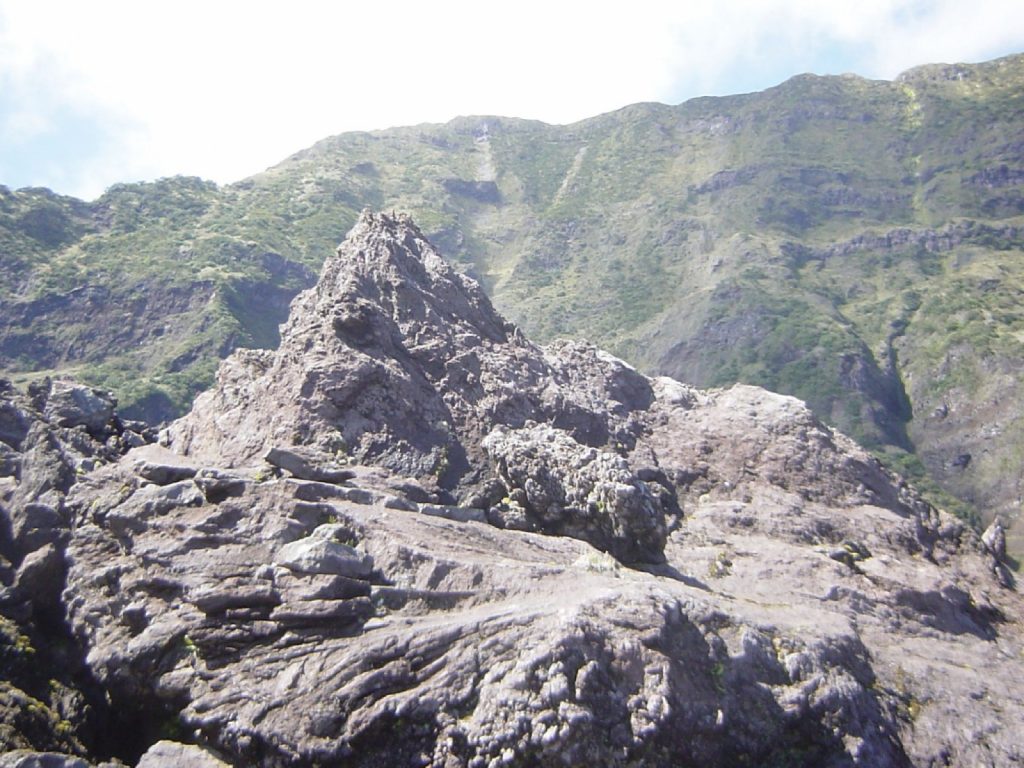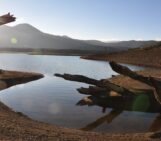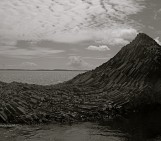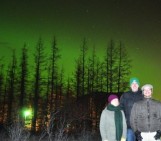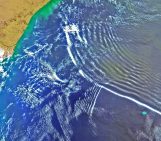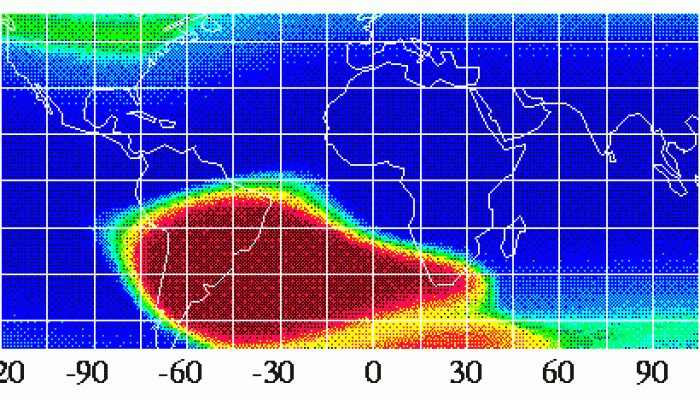
Geotalk is a regular feature highlighting early career researchers and their work. In this interview we speak to Jay Shah, a PhD student at Imperial College London, who is investigating the South Atlantic Anomaly, a patch over the South Atlantic where the Earth’s magnetic field is weaker than elsewhere on the globe. He presented some of his recent findings at the 2017 General Assembly.
First, could you introduce yourself and tell us a little more about your career path so far?
I’m currently coming to the end of my PhD at Imperial College London. For my PhD, I’ve been working with the Natural Magnetism Group at Imperial and the Meteorites group at the Natural History Museum, London to study the origin of magnetism in meteorites, and how meteoritic magnetism can help us understand early Solar System conditions and formation processes.
Before my PhD I studied geology and geophysics, also at Imperial, which is when I studied the rocks that I spoke about at the 2017 EGU General Assembly.
What attracted you to the Earth’s magnetic field?
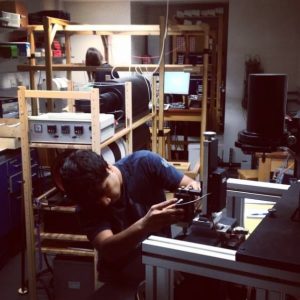
Jay operates the Vibrating Sample Magnetometer at the lab at Imperial. Credit: Christopher Dean/Jay Shah
My initial interest in magnetism, the ‘initial spark’ if you like, was during my undergraduate, when the topic was introduced in standard courses during my degree.
The field seemed quite magical: palaeomagnetists [scientists who study the Earth’s magnetic field history] are often known as palaeomagicians. But it’s through rigorous application of physics to geology that palaeomagicians can look back at the history of the Earth’s magnetic field recorded by rocks around the world. I was attracted to the important role palaeomagnetism has played in major geological discoveries such as plate tectonics and sea-floor spreading.
Then, during my undergraduate I had the opportunity to do some research alongside my degree, via the ‘Undergraduate Research Opportunities Programme’ at Imperial. It was certainly one of the bonuses of studying at a world-class research university where professors are always looking for keen students to help move projects forward.
I was involved in a project which focused on glacial tillites [a type of rock formed from glacial deposits] from Greenland to look into inclination shallowing; which is a feature of the way magnetism is recorded in rocks that can lead to inaccurate calculation of palaeolatitutdes [the past latitude of a place some time in the past]. Accurate interpretation of the direction of the Earth’s magnetic field recorded by rocks is essential to reconstructing the positions of continents throughout time.
This was my first taste of palaeomagnetism and opened the doors to the world of research.
So, then you moved onto a MSci where one of your study areas is Tristan da Cunha, a volcanic island in the South Atlantic. The location of the island means that you’ve dedicated some time to studying the South Atlantic Anomaly (SAA). So, what is it and why is it important?
The SAA is a present day feature of the magnetic field and has existed for the past 400 years, at least, based on observations. It is a region in the South Atlantic Ocean where the magnetic field is weaker than it is expected to be at that latitude.
The Earth’s magnetic field protects the planet and satellites orbiting around Earth from charged particles floating around in space, like the ones that cause aurorae. The field in the SAA is so weak that space agencies have to put special measures in place when their spacecraft orbit over the region to account for the increased exposure to radiation. The Hubble telescope, for example, doesn’t take any measurements when it passes through the SAA and the International Space Station has extra shielding added to protect the equipment and astronauts.
If you picture the Earth’s magnetic field: it radiates from the poles towards the Earth’s equator, like butterfly wings extending out of the planet. In that model, which is what palaeomagnetic theory is based on, it is totally unexpected to have a large area of weakness.
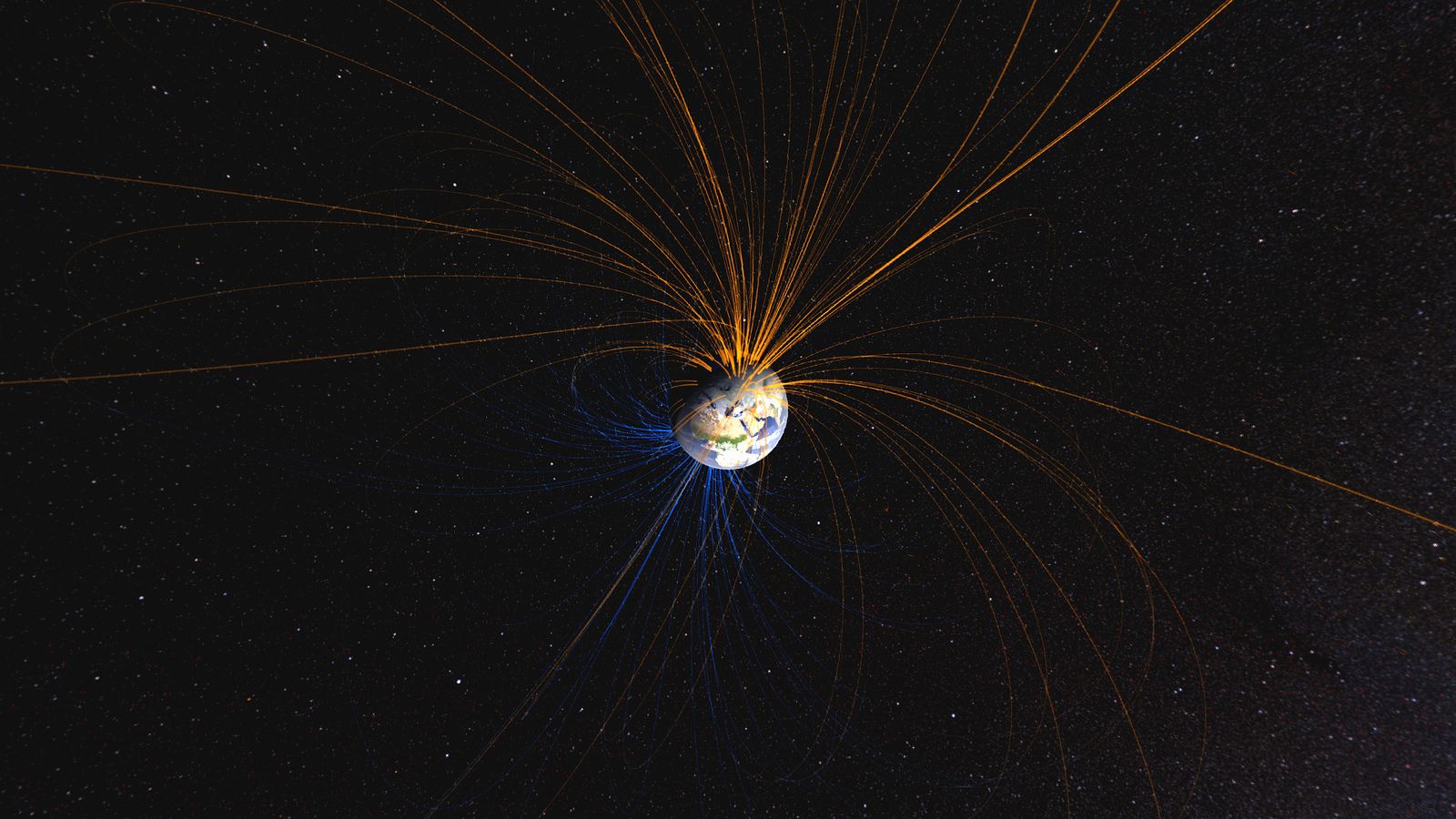
Earth’s magnetic field connects the North Pole (orange lines) with the South Pole (blue lines) in this NASA-created image, a still capture from a 4-minute excerpt of “Dynamic Earth: Exploring Earth’s Climate Engine,” a fulldome, high-resolution movie. Credit: NASA Goddard Space Flight Center
We also know that the Earth’s magnetic field reverses (flips its polarity), on average, every 450,000 years. However, it has been almost twice as long since we have had a flip, which means we are ‘overdue’ a reversal. People like to look for signs that the field will reverse soon; could it be that the SAA is a feature of an impending (in geological time!) reversal? So, it becomes important to understand the SAA in that respect too.
So, how do you approach this problem? If the SAA is something you can’t see, simply measure, how do you go about studying it?
Palaeomagnetists can look to the rock record to understand the history of the Earth magnetic field.
Volcanic rocks best capture Earth’s magnetic field because they contain high percentages of iron bearing minerals, which align themselves with the Earth’s magnetic field as the lavas cool down after being erupted. They provide a record of the direction and the strength of the magnetic field at the time they were erupted.
In particular, I’ve been studying lavas from Tristan da Cunha (a hotspot island) in the Atlantic Ocean similar in latitude to South Africa and Brazil. There are about 300 people living on the island, which is still volcanically active. The last eruption on the island was in 1961. In 2004 there was a sub-marine eruption 24 km offshore.
Jürgen Matzka (GFZ Potsdam) collected hundreds and hundreds of rock cores from Tristan da Cunha on sampling campaigns back in 2004 and 2006.
We recently established the age of the lavas we sampled as having erupted some 46 to 90 thousand years ago. Now that we know the rock ages, we can look at the Earth’s magnetic field during this time window.
Why is this time window important?
These lavas erupted are within the region of the present day SAA, so we can look to see whether any similar anomalies to the Earth’s magnetic field existed in this time window.
So, what did you do next?
Initial analyses of these rocks focused on the direction of the magnetic field recorded by the rocks. The directional data can be used to trace back past locations of the Earth’s magnetic poles.
Then, during my master’s research dissertation I had the opportunity to experiment on the rocks from Tristan da Cunha with the focus on palaeointensity [the ancient intensity of the Earth’s magnetic field recorded by the rocks]. We found that they have the same weak signature we observe today in the SAA but in this really old time window.
The rocks from Tristan da Cunha, 46 to 90 thousand years ago, recorded a weaker magnetic field strength compared to the strength of the magnetic field of the time recorded by other rocks around the world.
What does this discovery tell us about the SAA?
I mentioned at the start of the interview that, as far as we thought, the anomaly didn’t extend back more than 400 years ago – it’s supposed to be a recent feature of the field. Our findings suggest that the anomaly is a persistent feature of the magnetic field. Which is important, because researchers who simulate how the Earth’s magnetic field behaved in the past don’t see the SAA in simulations of the older magnetic field.
It may be that the simulations are poorly constrained. There are far fewer studies (and samples) of the Earth’s magnetic directions and strengths from the Southern Hemisphere. This inevitably leads to a sampling bias, meaning that the computer models don’t have enough data to ‘see’ the feature in the past.
However, we are pretty certain that the SAA isn’t as young as the simulations indicate. You can also extract information about the ancient magnetic field from archaeological samples. As clay pots are fired they too have the ability to record the strength and direction of the magnetic field at the time. Data recorded in archaeological samples from southern Africa, dating back to 1250 to 1600 AD also suggest the SAA existed at the time.
Does the fact that the SAA is older than was thought mean it can’t used be to indicate a reversal?
It could still be related to a future reversal – our findings certainly don’t rule that out.
However, they may be more likely to shed some light on how reversals occur, rather than when they will occur.
It’s been suggested that the weak magnetic anomaly may be a result of the Earth’s composition and structure at the boundary between the Earth’s core and the mantle (approximately 3000 km deep, sandwiched between the core and the Earth’s outermost layer known as the crust). Below southern Africa there is something called a large low shear velocity province (LLSVP), which causes the magnetic flux to effectively ‘flow backwards’.
These reversed flux patches are the likely cause of the weak magnetic field strength observed at the surface, and could well indicate an initiating reversal. However, the strength of the Earth’s magnetic field on average at present is stronger than what we’ve seen in the past prior to field reversals.
The important thing is the lack of data in the southern hemisphere. Sampling bias is pervasive throughout science, and it’s been seen here to limit our understanding of past field behaviour. We need more data from around the world to be able to understand past field behaviour and to constrain models as well as possible.
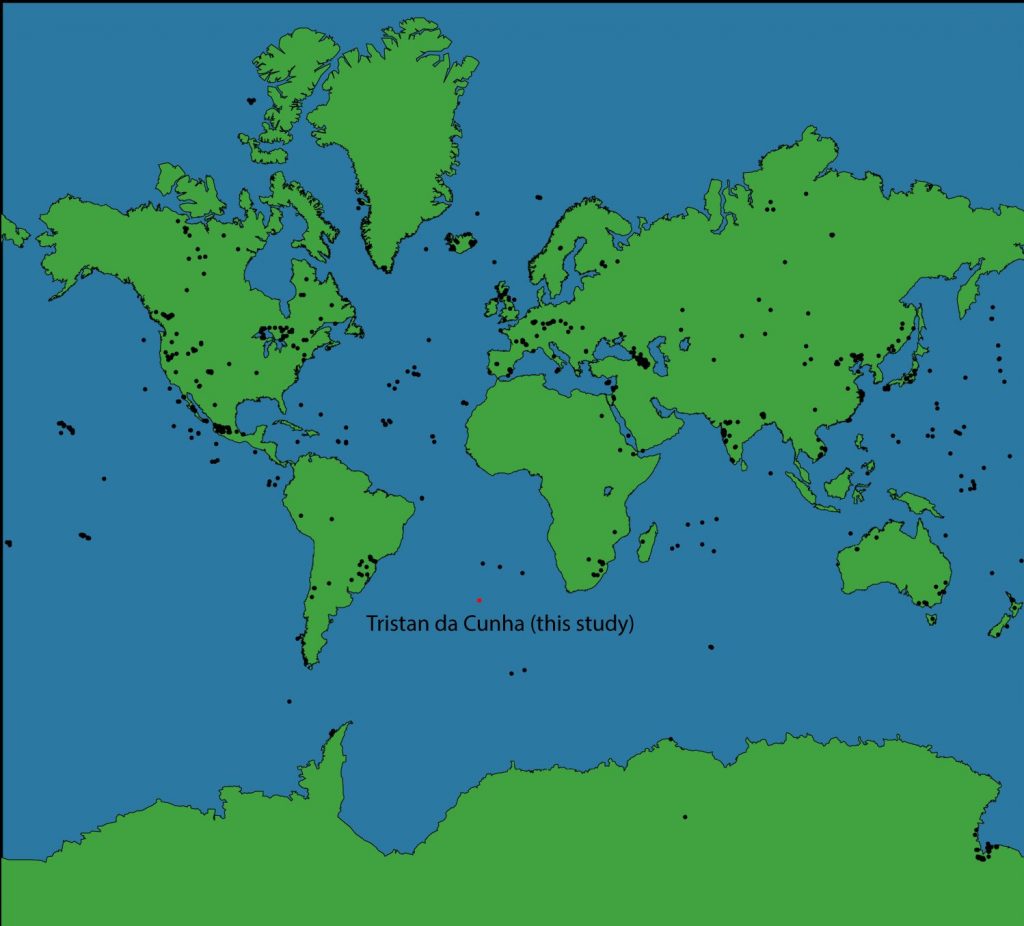
Sampling bias is pervasive throughout science, and it’s been seen here to limit our understanding of past field behaviour. This image highlights the problem (black dots = a sampling location). Modified from an image in the supporting materials of Shah, J., et al. 2016. Credit: Jay Shah.
You are coming towards the end of your PhD – what’s next?
So I moved far away from Tristan da Cunha for my PhD and have been looking at the magnetism recorded by meteorites originating from the early Solar System. I’d certainly like to pursue further research opportunities working with skills I’ve gained during my PhD. I want to continue working in the magical world of magnetism, that’s for sure! But who knows?
Something you said at the start of the interview struck me and is a light-hearted way to round-off our chat. You said that palaeomagnetism are often referred to as ‘paleaomagicians’ by others in the Earth sciences, why is that so?
Over the history of the geosciences, palaeomagntists have contributed to shedding light on big discoveries using data that not very many people work with. It’s not a big field within the geosciences, so it’s shrouded in a bit of mystery. Plus, it’s a bit of a departure from traditional geology, as it draws so heavily from physics. And finally, it’s not as well established as some of the other subdisciplines within geology and geophysics, it’s a pretty young science. At least, that’s why I think so, anyway!
Interview by Laura Roberts Artal, EGU Communications Officer
References and further reading
Shah, J., Koppers, A.A., Leitner, M., Leonhardt, R., Muxworthy, A.R., Heunemann, C., Bachtadse, V., Ashley, J.A. and Matzka, J.: Palaeomagnetic evidence for the persistence or recurrence of geomagnetic main field anomalies in the South Atlantic. Earth and Planetary Science Letters, 441, pp.113-124, doi: 10.1016/j.epsl.2016.02.039, 2016.
Shah, J., Koppers, A.A., Leitner, M., Leonhardt, R., Muxworthy, A.R., Heunemann, C., Bachtadse, V., Ashley, J.A. and Matzka, J.: Paleomagnetic evidence for the persistence or recurrence of the South Atlantic geomagnetic Anomaly. Geophysical Research Abstracts, Vol. 19, EGU2017-7555-3, 2017, EGU General Assembly 2017.

